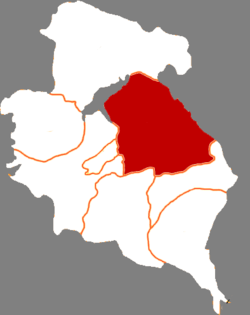Dongxiang Autonomous County
Dongxiang Autonomous County (simplified Chinese: 东乡族自治县; traditional Chinese: 東鄉族自治縣; pinyin: Dōngxiāngzú Zìzhìxiàn; Santa: Dunxianzu Zizhixien) is an autonomous county in the Linxia Hui Autonomous Prefecture, province of Gansu of the People's Republic of China. With ethnic minority of the Dongxiang.
Dongxiang Autonomous County 东乡族自治县 | |
|---|---|
 The northwestern edge of Dongxiang Autonomous County (Hetan Township) seen from across the Daxia River from the neighboring Linxia County | |
 Dongxiang in Linxia | |
.png) Linxia in Gansu | |
| Coordinates: 35°39′50″N 103°23′21″E | |
| Country | People's Republic of China |
| Province | Gansu |
| Autonomous prefecture | Linxia |
| Time zone | UTC+8 (China Standard) |
Towns
Dongxiang Autonomous County contains the town of Tangwangchuan.[1][2]
Tangwangchuan
A town called Tangwangchuan (唐汪川) in Dongxiang Autonomous County had a multi ethnic populace, the Tang (唐) and Wang (汪) families being the two major families. The Tang and Wang families were originally of non-Muslim Han Chinese extraction, but by the 1900s some branches of the families became Muslim by "intermarriage or conversion" while other branches of the families remained non-Muslim.[3]
People in the area have changed their ethnicity by marrying members of other groups or converting to their religion. The Tang and Wang families are now composed of all three different ethnic groups, with Han Chinese, Hui and Dongxiang people. The Hui and Dongxiang are Muslims.[4]
Tangwangchuan and Hanjiaji were notable for being the lone towns with a multi ethnic community, with both non-Muslims and Muslims.[5]
The Kuomintang official Ma Hetian visited Tangwangchuan and met an "elderly local literatus from the Tang clan" when he was on his inspection tour of Gansu and Qinghai.[6]
In the local music of Hezhou/Linxia, a Han and Hui song called "Hezhou" contains the verse "tang wang chuan you yi ge" (唐汪川有一个) in its third Ling.[7]
Transport
Sources
- Vadim Mikhaĭlovich Masson (1999). Ahmad Hasan Dani; Vadim Mikhaĭlovich Masson (eds.). History of civilizations of Central Asia, Volume 1. Motilal Banarsidass. p. 325. ISBN 81-208-1407-X. Retrieved 17 July 2011.
- Vadim Mikhaĭlovich Masson (1999). Ahmad Hasan Dani; Vadim Mikhaĭlovich Masson (eds.). History of civilizations of Central Asia, Volume 1. Motilal Banarsidass. p. 320. ISBN 81-208-1407-X. Retrieved 17 July 2011.
- Gail Hershatter (1996). Gail Hershatter (ed.). Remapping China: fissures in historical terrain (illustrated ed.). Stanford University Press. p. 102. ISBN 0-8047-2509-8. Retrieved 17 July 2011.
- M.E. Sharpe, Inc, International Arts and Sciences Press (2007). Chinese sociology and anthropology. M.E. Sharpe. p. 42. Retrieved 17 July 2011.CS1 maint: multiple names: authors list (link)(Original from the University of Virginia )
- Jonathan Neaman Lipman (1997). Familiar strangers: a history of Muslims in Northwest China (illustrated ed.). University of Washington Press. p. 145. ISBN 0-295-97644-6. Retrieved 17 July 2011.
- University of Cambridge. Mongolia & Inner Asia Studies Unit (2002). Inner Asia, Volume 4, Issues 1-2. The White Horse Press for the Mongolia and Inner Asia Studies Unit at the University of Cambridge. p. 119. Retrieved 17 July 2011.(Original from the University of Michigan)
- European Foundation for Chinese Music Research (1999). Journal of the CHIME Foundation, Issues 12-13. European Foundation for Chinese Music Research. p. 80. Retrieved 17 July 2011.(Original from the University of Michigan)
- Martin Hartmann (1921). Zur Geschichte des Islam in China. Volume 10 of Quellen und Forschungen zur Erd- und Kulturkunde. W. Heims. p. 14. Retrieved 17 July 2011.(Original from the University of Michigan)
| Wikimedia Commons has media related to Dongxiang Autonomous County. |